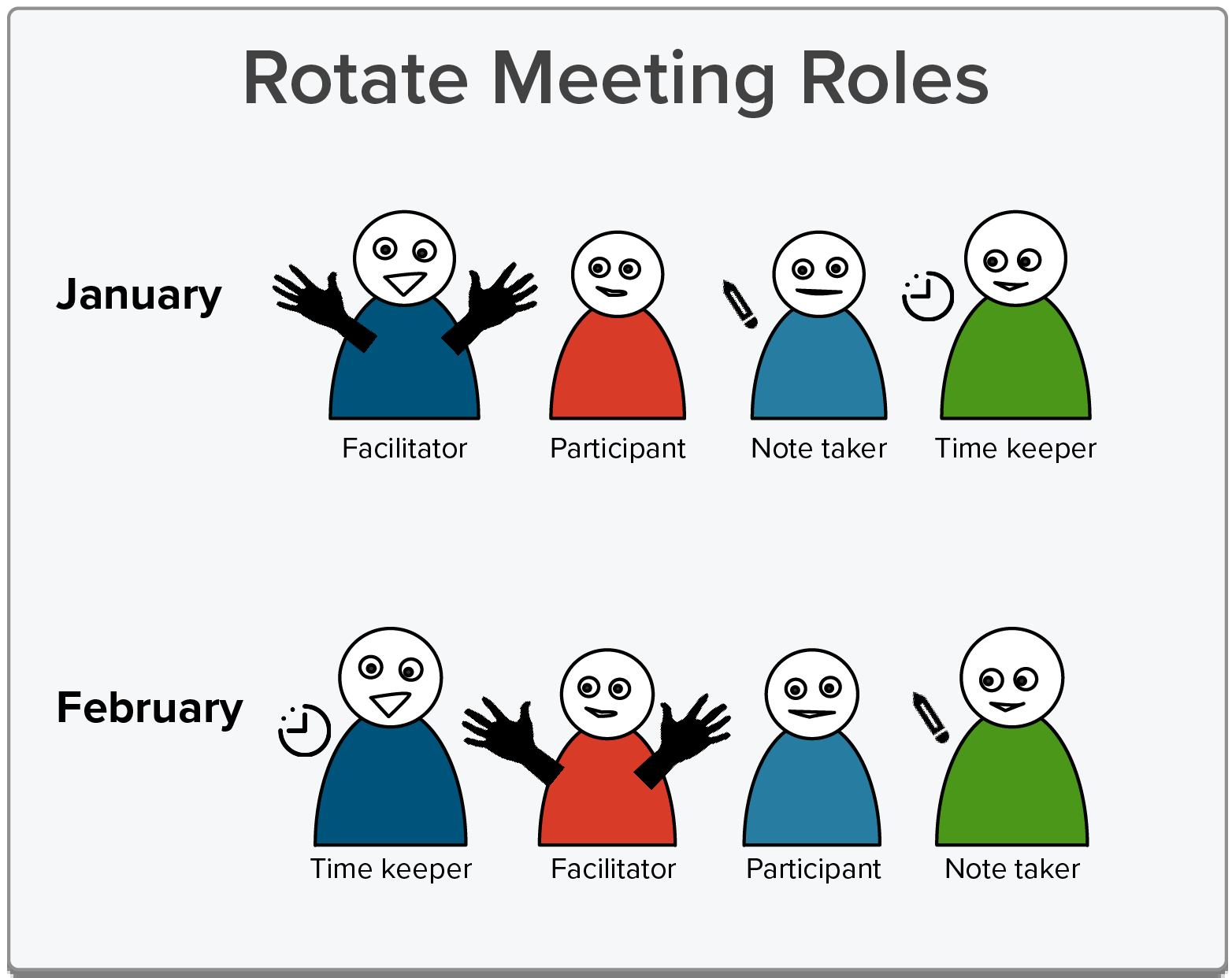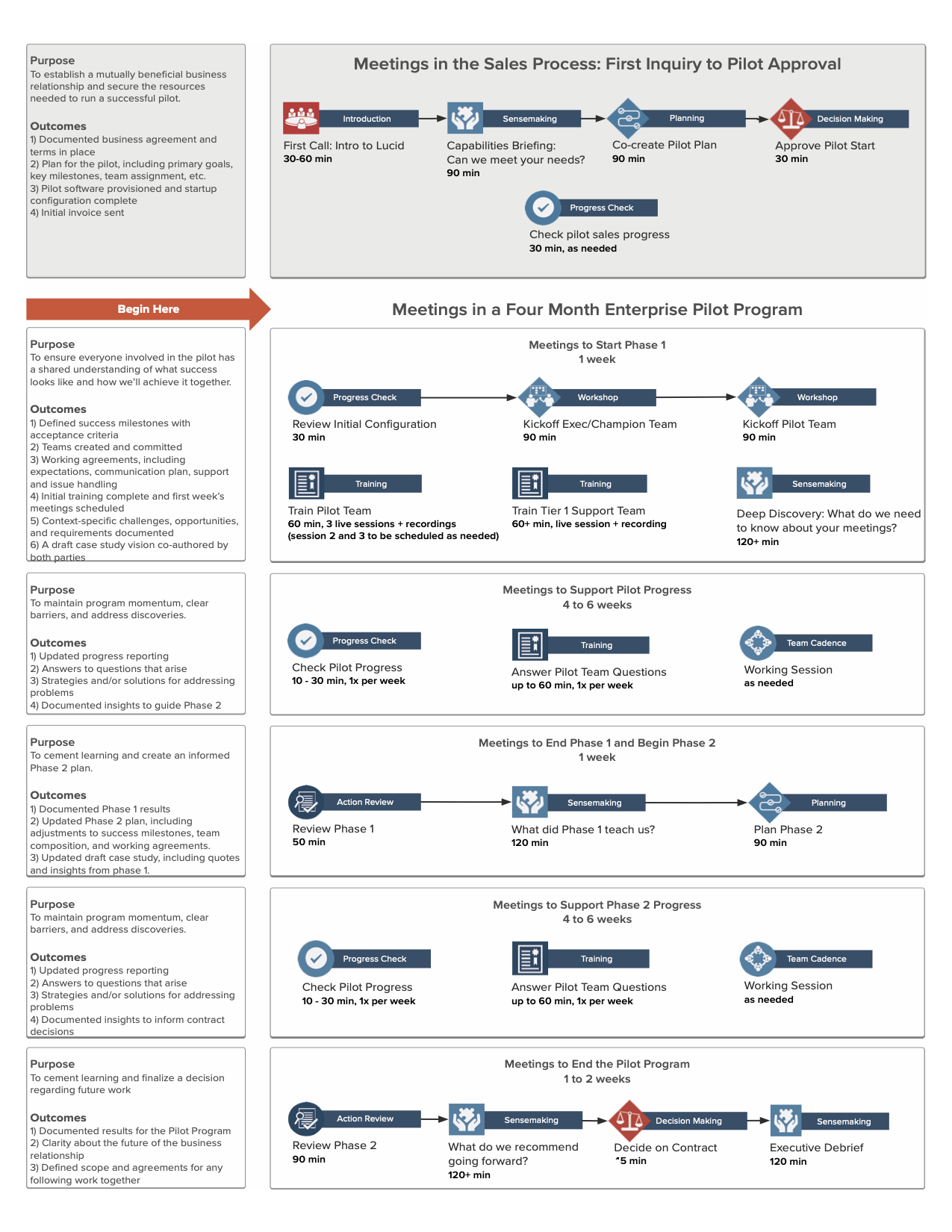5 Rules for Leading Excellent Meetings with Your Team Every Day
Successful businesses do the things that others know they should do …. but generally don’t.
~ Ari Weinzwig’s 7th Natural Law of Business
So let’s talk about those things you need to do to run great everyday business meetings with your teams. And yes, I’m going to share some guidelines you may already know.
Hopefully, you’ll be inspired to follow them.
It’s worth the effort. The leaders we’ve met who follow these “rules” enjoy more productivity, more loyalty, more engagement, better decision making, and less BS drama between team members than everyone else. And frankly, none of this is actually that hard to do.
Here are five rules for team meetings that I share with my business clients, and that I wish someone had taught me when I started my business.

Let’s look at the details.
Rule 1. Design your meeting system.
Most advice you’ll see about meetings tells you to create an agenda, or stand up, or keep it short, or some other set of simplistic steps you’re supposed to follow every time you schedule a meeting.
Business leaders don’t have time to follow any list of “should do” steps every time they need to meet, no matter how simple or brilliant that list might be.
You do not have time for that!
Instead, you need to sit down and design how your team works-your Way of Working-once. It’s a system. Then, you go to work, and you tweak it as you go.
Do you work with a sales consultant or product development coach? These professionals will give you language for many of the meetings you’ll use in your sales and product development processes, so you already have what you need to design those conversations.

You need to take the same care with the rest of your internal meetings. What does your weekly team meeting look like? How often do you review lessons learned? How do you bring on a new team member? How do you meet to make sure your projects are on track? What’s your approach to performance management?
Each and every one of these meetings can be mapped out as a part of how your team gets work done. If you don’t have any of this in place yet, this article provides an example of one way this might look.
Rule 2. Take and review notes every time.
You should have records from all of your meetings except for the purely social events and any meetings in which you agree to a life of crime. Don’t document your evil plans.
Otherwise, you want records for everything else, because those meetings created new value for your business.
In the section dedicated to meeting records in our course on science-backed meeting rules, Dr. Joseph Allen shares an experiment he ran with several teams at a large company.
Here’s how it worked. One team was asked to write down action items and review them before the end of their meetings. The other teams didn’t make any changes.
Their findings? The team that simply wrote down what they’d decided and what they agreed to do quickly outperformed all the other teams.
So simple! So obvious! But very few teams do it, so they end up rehashing the same conversations many times. That’s just dumb and wasteful.
If you haven’t already, capturing meeting records is the simplest meeting discipline you can adopt, and because most teams don’t bother, it gives you a serious competitive advantage.
Here’s one way those meeting records will pay off.
Rule 3. Rotate responsibility.
Once you’ve designed your way of working, and established a regular habit of recording the decisions and action items that come out of those meetings, you no longer have to run the meetings.
In fact, it’s better for you and your team if you don’t.
Instead, take turns. Give each person on your team a meeting job to do, then rotate those jobs on a regular basis. One person prepares the agenda and keeps the conversation on track. One person watches the time. One takes notes.

By doing this, you’re not only making your life easier, you’re also building the capacity of your team. You are creating more leaders who you can trust to take on more of the customer-facing work.
Finally, when your team can run great meetings and documents the results, you don’t have to always go to the meeting. If you, like me, have times where you need to work with a client or go on vacation, you can do that without worrying you’ll miss out. Your team knows what to do, they’ve had practice, and they’ll take great notes you can review when you’re back.
Rule 4. Build a home for stuff that comes up.
Most of us are pretty good at drawing up plans for the way we think our businesses ought to run, so I’m sure you’ll be able to pull a core Way of Working plan together.
You can absolutely do that, and you should. That’s the number one rule!
And like all plans, your plan will also be kind of crap.
When you plan, you’ll think you only need one meeting per week with your team, but then stuff comes up. You think you’ll need to refresh your strategy every 90 days, but then there will be something like, oh, say a pandemic? And there goes that strategy.
Does that mean your design work was futile? No – just incomplete.
Instead, every business owner needs to create a home for the “stuff comes up” stuff. Most don’t. Most let stuff that comes up spill willy-nilly all over their calendars, which erodes any chance your team has of getting work done on time.
To get in front of that, dedicate time on your calendar for “stuff”. Create at least one hour, every week, where your team can come with the stuff and work through it together.
At Zingerman’s, team members bring topics marked with what they need out of the discussion (e.g., A for announcement, H for help, D for decision) and how much time they need to talk it through. Coda holds a “Bullpen” every week, where everyone must attend and small groups can work out the little “stuff” that doesn’t fit in other meetings. Teams from dental offices to complexity scientists use a real-time agenda.
Whatever mechanism you choose, the goal is this: if something needs to be discussed that doesn’t fit in your pre-designed meetings, you can talk about it there.
Put this in place and you and your team will gain control over your calendars; short of a true emergency, you’ll be able to predict your meeting schedule and plan for uninterrupted focus time around it.
Rule 5. Bake in a culture that will make you and your team proud.
Meetings are about productivity and results and getting work done.
Meetings are also about:
- relationships
- fun
- inclusion
- meaning
- belonging!
Meetings are concentrated culture in action.
Meetings are the most frequently repeated, most visible, and most powerful opportunity you have to model and live your desired corporate culture. Don’t waste that opportunity.
Nowhere is it easier to see the beliefs that drive your team forward and the beliefs that hold you back.
If your culture encourages power struggles, blame, and evasion, you’ll see it when you meet. If you like to have fun, or if you’re passionate about the work, you’ll see that too.
So how can you ensure your meetings reflect the culture you want?
First, consider what you call your meetings and how you describe what you’re doing in the meeting.
For example, would you run a check-in, a stand-up, a huddle, a synch-up, an adrenaline call, or a fusion cell? These are all names different teams have given to a functionally identical meeting as a way to make it their own.
In social psychology circles, they call this use of intentional language priming or framing. The way you frame a meeting sets the tone and the boundaries, and shifts how everyone shows up.
Another example: check out this Twitter thread of stories about how the names a team gives their meeting rooms can impact how they feel about those meetings.
Next, look to your rituals.
Some companies design meetings that are nothing but ritual. Awards ceremonies, virtual happy hours – each of these gatherings works to strengthen the group’s shared identity.
Great rituals don’t have to take up a whole meeting, though. Many of the most effective rituals provide meaning to the start and end of meetings.
For example, the Canadian government convened a series of meetings between First Nations representatives and government ministers with a goal of improving relations. The first few were rough. The issues involved go way back, everyone had a vested interest to protect, and the discussion turned ugly.
Then, they changed how they began the meetings. Instead of just calling the meeting to order and launching into the agenda, they invited a First Nations elder to open meetings with a smudging. Smudging is a traditional ceremony used to clear negative energy and bless a space. The smudging did its job and reset the energy. Ministers who had been defensive began to listen, ask questions, and offer solutions.
As one witness related, “It was amazing. Such a small thing, but it made a huge difference.”
Which brings us full circle.
In business, we have so many meetings that they all blur together.
We forget sometimes that we, as business leaders, hold the power to transform those many otherwise forgettable, small moments into something memorable and powerful.
When we apply design, intention, and a healthy heap of love into how we show up with our teams, that’s when we start to build the companies that others hope to become.
Successful businesses leaders meet the way others know they should do …. but generally don’t.
As you build your meetings into something amazing, I hope you will share your stories too. I look forward to being inspired by the great good you create as you step up to lead excellent everyday meetings with your team.
Need help with that? Get in touch. This is what we do.


